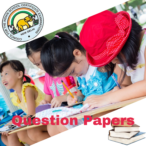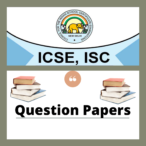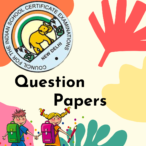BIOLOGY
SCIENCE Paper – 3
SECTION -I
Attempt all questions from this Section
![]() Q.1 (a) Name the following:
Q.1 (a) Name the following:
(i) The layer of the eyeball that provides nourishment to the eye.
(ii) One gaseous compound which depletes the ozone layer.
(iii) The structure which connects the placenta and the foetus.
(iv) A pair of corresponding chromosomes of the same shape and size and derived one from each parent.
(v) The compound formed when haemoglobin combines with carbon dioxide in blood.
(b) Correct and rewrite the statements by changing the biological term that is underlined for each statement:
(i) The theory of Inheritance of Acquired Characters was proposed by Watson and Crick.
(ii) The protective sac which develops around the developing embryo is called the Pericardium.
(iii) Maintaining balance of the body and coordinating muscular activities is carried out by the cerebrum.
(iv) The kidney is composed of number of neurons.
(v) The part of the eye which can be donated from a clinically dead person is the Retina.
(c) Give suitable biological reasons for the following statements:
(i) The birth rate in India is very high.
(ii) Carbon monoxide is dangerous when inhaled.
(iii) Root hairs become flaccid and droop when excess fertilizers are added to the moist soil around them.
(iv) Acid rain is harmful to the environment.
(v) All life on Earth is supported by Photosynthesis.
(d) Match the items given in Column A with the most appropriate ones in Column B and REWRITE the correct matching pairs:
| Column A | Column B |
|
(i) Cranial nerves (ii) Leydig cells (iii) Acetylcholine (iv) Spinal nerves (v) Sneezing |
– Testosterone – Natural reflex – 12 pairs – Prolactin – Neurotransmitter – 18 pairs – 31 pairs – Conditioned reflex |
(e) Choose the correct answer from the four options given below:
(i) While recording the pulse rate, where exactly does a doctor press on our wrist?
A. Nerve
B. Vein
C. Artery
D. Capillary
(ii) In a human male, a sperm will contain:
A. Both X and Y chromosomes
B. Only Y chromosome
C. Only X chromosome
D. Either X or Y chromosome
(iii) A muscular wall is absent in:
A. Capillary
B. Venule
C. Arteriole
D. Vein
(iv) On which day of the menstrual cycle does ovulation take place?
A. 5th day
B. 28th day
C. 14th day
D. 1st day
(v) Which one of the following does not affect the rate of transpiration?
A. Light
B. Humidity
C. Wind
D. Age of the plant
(f) Identify the ODD term in each set and name the CATEGORY to which the remaining three belong:
Example: glucose, starch, cellulose, calcium
Odd term: calcium
Category: others are different types of carbohydrates.
(i) Addison’s disease, Cushing’s Syndrome, Acromegaly, Leukemia. (ii) Insulin, Adrenaline, Pepsin, Thyroxine.
(iii) Axon, Dendron, Photon, Cyton.
(iv) Chicken pox, Colour blindness, Haemophilia, Albinism.
(v) Polythene bag, Crop residue, Animal waste, Decaying vegetable.
(g) Expand the following biological abbreviations:
(i) ABA
(ii) IAA
(iii) ATP
(iv) DNA
(v) TSH
(h) Study the picture given below and answer the following questions:
(i) Identify the type of pollution.
(ii) Name one pollutant that causes the above pollution.
(iii)Mention the impact of this pollution on human health.
(iv) State one measure to control this pollution.
(v) What is a ‘Pollutant’? Explain the term.
Answer:
(a) (i) Choroid
(ii) Chlorofluorocarbon (CFC) or carbon tetrachloride
(iii) Umbilical cord
(iv) Homologous chromosomes
(v) Carbaminohaemoglobin/HbCO2
(b) (i) Jean-Baptiste Lamarck
(ii) Amnion
(iii) Cerebellum
(iv) Nephrons/ Uriniferous tubules
(v) Cornea
(c) (i) Illiteracy, children are a gift of God, sign of prosperity, due to high infant mortality, more helping hands for family income, do not accept family planning methods, desire for a male child, lack of recreation.
(ii) Easily combines with haemoglobin to form carboxyhaemoglobin which cuts off supply of oxygen to tissues.
(iii) Formation of hypertonic solution which results in plasmolysis / exosmosis.
(iv) Pollutes soil, damages vegetation, buildings, statues, monuments, kills fish and aquatic animals.
(v) All organisms depend directly or indirectly on green plants for food, beginning of all food chains, provides oxygen for respiration.
(d)
|
Sr. No. |
Column A |
Column B |
|
(i) |
Cranial nerves |
12 pairs |
|
(ii) |
Leydig cells |
Testosterone |
|
(iii) |
Acetylcholine |
Neurotransmitter |
|
(iv) |
Spinal nerves |
31 pairs |
|
(v) |
Sneezing |
Natural reflex |
(e) (i) C. Artery
(ii) D. Either X or Y chromosome
(iii) A. Capillary
(iv) C. 14th day
(v) D. Age of the plant
(f) (i) O – Leukemia
C – Hormonal / Endocrinal disorders
(ii) O – Pepsin
C – Hormones
(iii) O – Photon
C – Parts of neuron / nerve cell
(iv) O – Chicken pox
C – Genetic diseases
(v) O – Polythene bag
C – Biodegradable wastes
(g) (i) Abscisic acid
(ii) Indole 3-acetic acid
(iii) Adenosine triphosphate
(iv) Deoxyribo nucleic acid
(v) Thyroid stimulating hormone
(h) (i) Water pollution/ Marine pollution
(ii) Detergents, sewage, domestic waste, oil spills from tankers, industrial wastes, hot water from thermal power plants, polythene covers, plastic bottles, dead bodies, insecticides, etc.
(iii) Enters food chain to harm health, cause diseases like typhoid, dysentery, jaundice, skin allergies, etc.
(iv) Treating industrial wastes and sewage before letting into water bodies, recycling plastic, metal and glass material
(v) Any constituent that harms the environment / deteriorates the natural quality of air, water, soil.
SECTION II (40 Marks)
Attempt any four questions from this Section.
![]() Q.2 (a) Given below is an experimental setup to demonstrate a particular tropic movement in germinating seeds. Study the diagram and answer the questions that follow:
Q.2 (a) Given below is an experimental setup to demonstrate a particular tropic movement in germinating seeds. Study the diagram and answer the questions that follow:
(i) Label the parts 1 and 2.
(ii) Name the tropic movement shown by part 1.
(iii) Part 1 is affected by two stimuli. Name them. Which one of the two is stronger?
(iv) What is Thigmotropism? Give one example.
(v) What is meant by ‘Positive’ and ‘Negative’ tropic movements in plants?
(b) Mention the exact location of the following:
(i) Testis
(ii) Incus
(iii) Thylakoids
(iv) Amniotic fluid
(v) Corpus callosum
Answer:
(a) (i)
- Radicle
- Plumule
(ii) Hydrotropism
(iii) Gravity, water / moisture
Water is stronger
(iv) Movement of plant in response to touch stimulus.
Pea, Vines, Cuscuta, cucumber
(v) Movement towards stimulus is positive.
Movement away from stimulus is negative.
(b) (i) Inside scrotal sac
(ii) Middle ear / between malleus and stapes
(iii) In chloroplast
(iv) Between amnion and foetus / surrounds the foetus
(v) Between the cerebral hemispheres.
![]() Q.3 (a) The diagram given below represents an experiment to prove the importance of a factor in photosynthesis. Answer the questions that follow:
Q.3 (a) The diagram given below represents an experiment to prove the importance of a factor in photosynthesis. Answer the questions that follow:
(i) Name the factor studied in this experiment.
(ii) What will you observe in the experimental leaf after the starch test?
(iii) Explain the process of Photosynthesis.
(iv) Give a balanced chemical equation to represent the process of photosynthesis.
(v) Draw a neat, labelled diagram of an experimental setup to show that oxygen is released during photosynthesis.
(b) State the main functions of the following:
(i) Medulla Oblongata
(ii) Cytokinins
(iii) Tears
(iv) Coronary Artery
(v) Seminal Vesicles
Answer:
(a) (i) Sunlight
(ii) – Part of leaf covered by black paper turns brown, absence of starch.
– Parts of leaf exposed to sunlight turns blue black, presence of starch.
(iii) Plant cells having chlorophyll, use water and carbon dioxide to produce glucose in the presence of sunlight.
(b) (i) Regulates activities of internal organs like breathing, heartbeat, peristalsis.
(ii) Stimulates cell division, plant growth, prevents ageing,expansion of cotyledons in seeds,breaks seed dormancy, promotes synthesis of chloroplasts, delays senescence.
(iii) Lubricates surface of eye, washes away dust, kill germs, keeps surface of eye moist, lysozyme kills bacteria.
(iv) Supplies oxygenated blood to the walls of the heart.
(v) Activates sperms, forms a medium for transportation of sperms.
![]() Q.4 (a) The diagram given below represents an organ system in the human body.
Q.4 (a) The diagram given below represents an organ system in the human body.
Study the same and answer the questions that follow:
(i) Identify the system.
(ii) Label the parts marked 2 and 4. Mention the function of part 5.
(iii) Name the structural and functional units of the part marked 1.
(iv) What is the fluid that accumulates in part 3? Which is the main nitrogenous waste present in it?
(v) Draw a neat, labelled diagram showing the longitudinal section of part 1.
(b) The diagram given below represents an endocrine gland in the human body.
Study the diagram and answer the following questions:
(i) Identify the endocrine gland. Where is it located?
(ii) Why is the above gland referred to as the ‘Master gland’?
(iii) Name the hormone which in deficiency causes Diabetes Insipidus.
How does this disorder differ from Diabetes Mellitus?
(iv) Explain the term ‘Hormone’. What is the role of Tropic hormones in the human body?
(v) Which lobe of the above gland secretes:
1. Oxytocin
2. ACTH
3. Growth hormone
Answer:
(a) (i) Excretory system/Urinary system
(ii) 2 – Ureter
4 – Sphincter
5 – Expels urine
(iii) Nephrons
(iv) Urine, Urea
(v)
(b) (i) Pituitary gland
Hangs from hypothalamus
(ii) Controls the secretions of other endocrine glands/regulates the activities of other endocrine glands.
(iii) Vasopressin / ADH
Diabetes mellitus is due to deficiency of insulin/ high level of sugar in blood, urine has sugar.
Diabetes insipidus: Normal sugar in blood, urine free of sugar / urine loaded with water.
(iv) It is the secretion of an endocrine gland, which is transported by blood and acts on target organs or cells.
Secreted by pituitary gland and stimulates other endocrine glands to secrete their hormones.
(v) 1 – Posterior/ neurohypophysis
2 – Anterior / adenohypophysis
3 – Anterior /adenohypophysis
![]() Q.5 (a) Given below is an apparatus which was setup to investigate a physiological process in plants. The setup was placed in bright sunlight. Answer the questions that follow:
Q.5 (a) Given below is an apparatus which was setup to investigate a physiological process in plants. The setup was placed in bright sunlight. Answer the questions that follow:
(i) Name the process being studied. Define the process.
(ii) Why was the pot enclosed in a rubber sheet?
(iii) Mention two external factors which can accelerate the above process.
(iv) List two adaptations in plants to reduce the above process.
(v) Draw a neat, labelled diagram of a stomatal apparatus.
(b) Given below are two stages in the evolution of man.
Study them and answer the questions that follow:
(i) Identify Australopithecus and Neanderthal man from the above pictures.
(ii) Mention two characteristic features each for the two stages.
(iii) Who proposed the theory of ‘Natural Selection’?
(iv) Name the organism used as an example to explain ‘Industrial Melanism’.
(v) Give two examples of Vestigial organs in humans.
Answer:
(a) (i) Transpiration
It is the loss of water as water vapour from the aerial parts of the plant.
(ii) To prevent evaporation of water from the pot/ soil.
(iii) Bright sunlight, high temperature, high velocity of wind, low humidity.
(iv) Thick cuticle, loss of leaves, narrow leaves, fewer stomata, sunken stomata, leaves modified into spines, multiple layers of epidermal cells.
(v)
(b) (i) A – Neanderthal man
B – Australopithecus
(ii) A – absolute bipedalism, large head, broad, flat, sloping forehead, less hair on body, large cranial capacity 1,500 cm3,
B – Protruding face, Chin absent, prominent eyebrow ridges, flat nose, projecting face, cranial capacity (450- 600 cm3).
(iii) Charles Darwin
(iv) Peppered moth / Biston betularia
(v) Pinna of ear, wisdom teeth, vermiform appendix, coccyx or tailbone, arrector pili, plica semilunaris, body hair, male nipples.
![]() Q.6 (a) In Mendel’s experiments, tall pea plants (T) are dominant over dwarf pea plants (t).
Q.6 (a) In Mendel’s experiments, tall pea plants (T) are dominant over dwarf pea plants (t).
(i) What is the phenotype and genotype of the F1 generation if a homozygous tall plant is crossed with a homozygous dwarf plant?
(ii) Draw a Punnett square board to show the gametes and offspring when both the parents are heterozygous for tallness.
(iii) What is the phenotypic ratio and genotypic ratio of the above cross in (ii)?
(iv) State Mendel’s Law of Dominance.
(v) What is a Dihybrid Cross?
(b) Given below is a diagram representing a stage during the mitotic cell division.
Study the diagram and answer the following questions:
(i) Identify the stage by giving a suitable reason.
(ii) Is it a plant or an animal cell? Give a reason to support your answer.
(iii) Draw a neat, labelled diagram of the stage which follows the one shown in the diagram.
(iv) How many chromosomes will each daughter cell have after the completion of the above division?
(v) Name the four nitrogenous bases.
Answer : (a) (i) Phenotype – all are tall plants
Genotype – All are hybrid / heterozygous dominant
(iii) Phenotypic ratio – 3 : 1
Genotypic ratio – 1 : 2 : 1
(iv) Out of a pair of contrasting characters, the one that is expressed is dominant and the one that is not expressed is recessive.
(v) It is breeding plants taking two pairs of contrasting characters.
(b) (i) Anaphase
Chromatids are being pulled towards the opposite poles.
(ii) Animal cell
Cell wall is absent, centrioles are present, asters are present.
(iii)
(iv) 4
(v) Adenine, Thymine, Cytosine, Guanine.
![]() Q.7 (a) Answer the following questions briefly:
Q.7 (a) Answer the following questions briefly:
(i) How are the cytons and axons placed in the brain and the spinal cord?
(ii) Which part of the human ear gives ‘Dynamic balance’ and ‘Static balance’ to the body?
(iii) Explain how the human eye adapts itself to bright light and dim light.
(iv) What is Parthenocarpy? Give one example.
(v) Mention any two objectives of ‘Swachh Bharat Abhiyan’.
(b) The diagram given below represents a system in the human body.
Study the diagram and answer the following questions:
(i) Identify the system.
(ii) Label the parts marked 5 and 6.
(iii) Name the two hormones secreted by 1.
(iv) Mention the number and the name of the part involved in fertilization and implantation from the above diagram.
(v) Mention the surgical methods of contraception in:
1. Human males.
2. Human females.
Answer:
(a) (i) Brain – Outer, grey matter has cytons and inner white matter has axons.
Spinal Cord – Outer, white matter has axons and inner grey matter has cytons.
(ii) Dynamic – semi-circular canals/ducts/tubes
Static – utriculus, sacculus, utricle, saccule, vestibule
(iii) Bright light – Pupils constrict, Rhodopsin is bleached.
Dim light – Pupils dilate, Rhodopsin is regenerated.
(iv) Formation of fruit without fertilisation e.g. grapes, water melon, banana, papaya.
(v) – To clean roads, streets and buildings in cities and towns.
– To eliminate open defecation
– To build and monitor the use of latrines
– To manage solid and liquid waste
(b) (i) Female reproductive system
(ii) 5 – Oviducal funnel
6 – Cervix
(iii) Oestrogen, Progesterone.
(iv) Fertilisation – 2, Oviduct/Fallopian tube
Implantation – 3, Uterus
(v) 1 – Vasectomy
2 – Tubectomy




